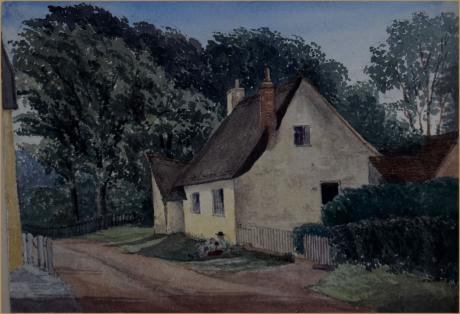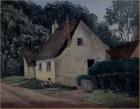inscribed and dated in the margin "Cottage, Sharnbrook, Beds, 1875
Sharnbrook is a village and civil parish located in the Borough of Bedford in Bedfordshire, England. The settlement was recorded in the Domesday Book of 1086 as a parish within the Hundred of Willey but was probably first developed in Saxon times. The oldest surviving building, St Peter's Church, is Norman. The name is believed to be derived from the Anglo Saxon word sharn meaning dung. Many of the older buildings in the village are constructed of the local oolitic limestone, also used in other traditional north Bedfordshire settlements.The village developed through agriculture, there were a number of landowners and many villagers held their cottages and the small pieces of land attached to them from the lord of a manor, in return for doing various agricultural jobs on the lords land.
St Peters Church is the oldest surviving building in the village. The church was originally Norman and the first recorded rector was William in about 1155. The Norman church was remodelled in the 13th Century, with further additions in the 14th, 15th and 17th Centuries in a mixture of architectural styles.The 17th Century saw a great period of building in the village, including Tofte Manor to the north side of the village and a number of houses at the lower end of the High Street. The old stone houses were originally small farm cottages, with individual strips of land behind them. Sharnbrook was home to eight manors, of which only three remain today including Tofte Manor but also Ouse Manor to the southeast of the village and Colworth House to the west and now home to Unilever. The others live on in road names around the village including Templars Way, Loring Road and Grange Gardens.The village developed as a commercial centre in the 19th Century. The railway came to Sharnbrook in 1857 and in 1871; there were millers, wheelwrights, blacksmiths, tailors, drapers, bakers and corn merchants in the village. A village school was founded in 1836, now John Gibbard Lower School, and a Police Station in 1872, now residential flats. The railway station closed in 1960 due to lack of demand.
Situated just north of a loop in the River Great Ouse and almost due north of Bedford, the village has developed as a ribbon-settlement running south-east to north-west, with the core of the community clustered at the north-western end. The village has two schools, the larger of which Sharnbrook Academy has a campus on the west of the village, serves a wide area and was attended by the marathon world record holder Paula Radcliffe, who opened the Paula Radcliffe Sharnbrook Community Sports Centre named after her in April 2005. This Community Sports Centre is not only for students but also serves the wider local community of North Bedfordshire with sporting facilities. Students are aged from 11 to 18 and take both GCSE and A Level exams. The village's other school is Sharnbrook Primary which caters for young children aged from 3–11 years old who live in the immediate area.
Another major presence is the multinational company Unilever which has a research centre on the north-western edge of the village. This uses the grounds of Colworth House, originally built in the early 17th century and rebuilt in its present form by 1774 as a private house. The house itself is used as office space, with modern laboratory buildings beside and behind it. The site is being turned into a science park for use by a number of companies.
Sharnbrook is the village where the prototype of Uncle Silas, Joseph Betts, the protagonist of H.E. Bates's My Uncle Silas lived.


